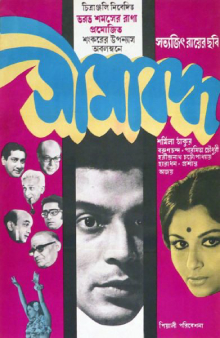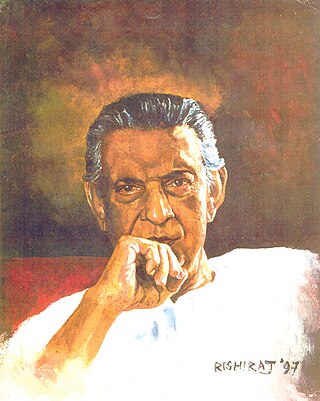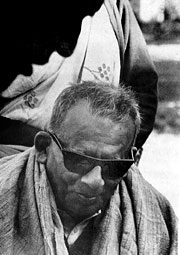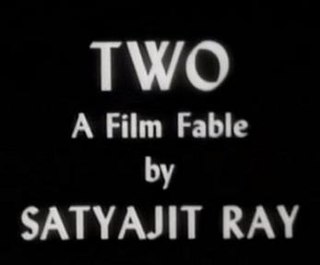
Charulata is a 1964 Indian drama film written and directed by Satyajit Ray. Based upon the novel Nastanirh by Rabindranath Tagore, it stars Soumitra Chatterjee, Madhabi Mukherjee and Sailen Mukherjee. The film is considered one of the finest works of Ray and is often featured in the lists of the greatest films ever made.
Bengali Brahmos are those who adhere to Brahmoism, the philosophy of Brahmo Samaj which was founded by Raja Rammohan Roy. A recent publication describes the disproportionate influence of Brahmos on India's development post-19th Century as unparalleled in recent times.

Nayak is a 1966 Indian Bengali-language drama film composed, written, and directed by Satyajit Ray. It was Ray's second entirely original screenplay, after Kanchenjungha (1962). The story revolves around a matinee idol on a 24-hour train journey from Kolkata to Delhi to receive a national award. However, he ends up revealing his mistakes, insecurities and regrets to a young journalist, who realises that behind all his arrogant facade lies a deeply troubled man as his life's story is gradually revealed through seven flashbacks and two dreams. The film starring Uttam Kumar in main protagonist and Sharmila Tagore played second lead.

Seemabaddha is a 1971 social drama Bengali film directed by Satyajit Ray. It is based on the novel Seemabaddha by Mani Shankar Mukherjee. It stars Barun Chanda, Harindranath Chattopadhyay, and Sharmila Tagore in lead roles. The film was the second entry in Ray's Calcutta trilogy, which included Pratidwandi (1970) and Jana Aranya (1976). The films deal with the rapid modernization of Calcutta, rising corporate culture and greed, and the futility of the rat race. The film won the FIPRESCI Award at the 33rd Venice International Film Festival, and the National Film Award for Best Feature Film in 1971.

Nandalal Bose was one of the pioneers of modern Indian art and a key figure of Contextual Modernism.

Satyajit Ray was an Indian filmmaker who worked prominently in Bengali cinema and who has often been regarded as one of the greatest and most influential directors in the History of cinema. Ray was born in Calcutta to a Bengali family and started his career as a junior visualiser. His meeting with French film director Jean Renoir, who had come to Calcutta in 1949 to shoot his film The River (1951), and his 1950 visit to London, where he saw Vittorio De Sica's Ladri di biciclette (1948), inspired Ray to become a film-maker. Ray made his directorial debut in 1955 with Pather Panchali and directed 36 films, comprising 29 feature films, five documentaries, and two short films.

Rabindranath Tagore is a 1961 Indian documentary film written and directed by Satyajit Ray about the life and works of noted Bengali author Rabindranath Tagore. Ray started working on the documentary in early 1958. Shot in black-and-white, the finished film was released during the birth centenary year of Rabindranath Tagore, who was born on 7 May 1861. Ray avoided the controversial aspects of Tagore's life in order to make it as an official portrait of the poet. Though Tagore was known as a poet, Ray did not use any of Tagore's poetry as he was not happy with the English translation and believed that "it would not make the right impression if recited" and people would not consider Tagore "a very great poet," based on those translations. Satyajit Ray has been reported to have said about the documentary Rabindranath Tagore in his biography Satyajit Ray: The Inner Eye by W. Andrew Robinson that, "Ten or twelve minutes of it are among the most moving and powerful things that I have produced."

Bala is a 1976 documentary film made by Satyajit Ray, about a Bharatanatyam dancer, Balasaraswati, fondly known as "Bala". The film was jointly produced by National Centre for the Performing Arts and Government of Tamil Nadu. The thirty-three-minute documentary features the life and some of the works by Balasaraswati in the form of narration and dance, starring herself. At the age of fourteen, Ray had seen a performance of Balasaraswati in Kolkata, then known as "Calcutta", in 1935, when she was seventeen years old.

Nastanirh is a 1901 Bengali novella by Rabindranath Tagore. It is the basis for the noted 1964 film Charulata, by Satyajit Ray.

Benode Behari Mukherjee was an Indian artist from West Bengal state. Mukherjee was one of the pioneers of Indian modern art and a key figure of Contextual Modernism. He was one of the earliest artists in modern India to take up to murals as a mode of artistic expression. All his murals depict a subtle understanding of environmental through pioneering architectural nuances.

Two: A Film Fable is a 1964 Indian black-and-white short film directed by Satyajit Ray. The film was made under the banner of Esso World Theater at the request of a non-profit American public broadcasting television, PBS. It was made as part of a trilogy of short films from India. The other two films in the trilogy featured Indian Sitar player, Pandit Ravi Shankar and a Ballet troupe from Mumbai, then known as "Bombay". Ray, who worked prominently for Bengali cinema, was requested to make a film in English language with a Bengali setting, however Ray being an admirer of silent film decided to make a film without any dialogue as a tribute to the genre.
Ramkinkar Baij was an Indian sculptor and painter, one of the pioneers of modern Indian sculpture and a key figure of Contextual Modernism.

Satyajit Ray was an Indian film director, screenwriter, author, lyricist, magazine editor, illustrator, calligrapher, and composer. Ray is widely considered one of the greatest and most influential film directors in the history of cinema. He is celebrated for works including The Apu Trilogy (1955–1959), The Music Room (1958), The Big City (1963), Charulata (1964), and the Goopy–Bagha trilogy (1969–1992).[a]
Soumendu Roy was an Indian cinematographer most known for his work with noted director Satyajit Ray's films, starting with Teen Kanya (1961), when Subrata Mitra developed an eye-problem, though he has earlier shot Ray's documentary Rabindranath Tagore (1961) and has been an assistant to Subrata in post Pather Panchali films.

Raman Siva Kumar, known as R. Siva Kumar, is an Indian contemporary art historian, art critic, and curator. His major research has been in the area of early Indian modernism with special focus on the Santiniketan School. He has written several important books, lectured widely on modern Indian art and contributed articles to prestigious international projects such as the Art Journal, Grove Art Online or The Dictionary of Art, Oxford University Press.

Kala Bhavana is the fine arts faculty of Visva-Bharati University, in Shantiniketan, India. It is an institution of education and research in visual arts, founded in 1919, it was established by Nobel laureate Rabindranath Tagore.

Suresh K. Nair is an artist based in Banaras. Nair obtained his national diploma in mural painting from the Institute of Mural Painting Guruvayur, Kerala under the guidance of Mammiyur Krishnan Kuty Nair. He was inspired by the works of Rabindranath Tagore, Nandalal Bose, Benode Behari Mukherjee and Ramkinker Baij and continued his studies at the Department of Painting, Visva Bharati University, Santiniketan. Nair has acquired a presence in the Indian and international art scene over the last decade with several shows organized by regional and international galleries and museums, and created many murals in India and abroad. His early works are based on Kerala murals, both in terms of technique and ideas. One of his modern paintings, ‘Cosmic Butterfly" is owned by Essl Museum, Vienna, Austria since 2010. His works were exhibited in the US, Spain, and Canada, and his awards include the Elizabath Green Shield Foundation Scholarship (1999) of Canada; Fulbright Fellowship ( 2006–07) for an Educational Exchange Program at Tyler School of Art, Temple University, Philadelphia under Professor Nicholas Kripal; and the State Award of Kerala Lalithkala Akademi, Ministry of Culture, Government of Kerala.
Santiniketan: The Making of a Contextual Modernism was an exhibition curated by R. Siva Kumar at the National Gallery of Modern Art in 1997, on the occasion of the 50th anniversary of India's Independence.
The following is a list of notable people associated withVisva- Bharati University and/or Santiniketan, a neighbourhood in Bolpur city in West Bengal, India:
Dinkar Kowshik (1918-2011) was an influential Indian painterand educator. As principal of Kala Bhavana at Santiniketan, he reshaped it for contemporary art practices.














